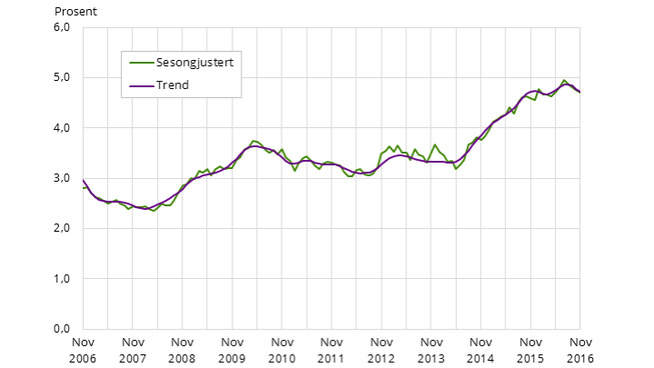the SSB registered to 130,000 unemployed persons in Norway in november. There is a fall in the unemployment rate to 4.7 percent, from 4.8 per cent the month before.
in Isolation, this is good news. But the survey shows that employment falls here in the country.
– the Reason why the unemployment rate has fallen is that the workforce has fallen more than employment, ” says Kari Due-Andresen, chief economist of Handelsbanken, to E24.
– What we have seen in the past is that yrkesdeltagelsen falls in all age groups. Thus, it is not decreasing the unemployment rate good news. People pull themselves out of the workforce because it has become more difficult to get a job, a little simple said, ” she says.
More outside the labour force
the November figures show namely a fall in the seasonally adjusted the employment rate of 66,8 percent, a decline of 0.5 percentage points since august. It represents 14.000 people, a change that, in isolation, is within the margin of error.

chief economist Kari Due-Andresen at Handelsbanken Capital Markets.
Since both the number of employed and unemployed persons went down, it means that the number of those who are outside the labour force, i.e. persons who do not offer employment on the labour market, went up.
– One does not completely explain the discrepancy, but what we can conclude is that employment does not rise. No matter how one looks at the labour market and the unemployment rate, regardless of where these are, then this is a svakhetstegn for the labour market, ” says Due-Andresen.
STATISTICS measures the unemployment rate through its labour force survey (LFS). The gures for november, is the average of the period October to December.
In advance, it was expected that the unemployment rate should remain unchanged at 4.8 per cent.
Since 2014 has the unemployment rate grown from just in excess of 3 per cent to a peak last summer at 5 per cent. The time was the unemployment rate measured the highest level since 1996.

OVER the LEDIGHETSKNEIKA? The unemployment rate shot momentum after oil prices set off the summer of 2014. The last few months has, however, fallen somewhat.
The past year, changes in the unemployment rate largely been within the margin of error and varied between 4.6 and 5 per cent of the labour force.
Different ledighetstall
the Lfs survey shows a far higher ledighetstall than the nav’s statistics show.

Fresh ledighetstall from NITO: – Things are worse than worst
In December, it was the registry 78.600 completely available at Nav, which constitutes 2.8 per cent.
But the statistics are very different.
the Register of statistics telling how many people have registered as unemployed with Nav. But it is far from all unemployed persons registered with Nav.
“It applies in particular to newcomers in the labour market, without requirements on unemployment benefits,” writes STATISTICS norway in a thematic paper about the differences between the Lfs figures and Nav figures for the unemployment rate.
to obtain the right to unemployment benefits, or unemployment benefits that Nav calls it, one must first have worked and paid taxes for a while.
- Share on Facebook
- Share on LinkedIn
Share on Twitter
No comments:
Post a Comment